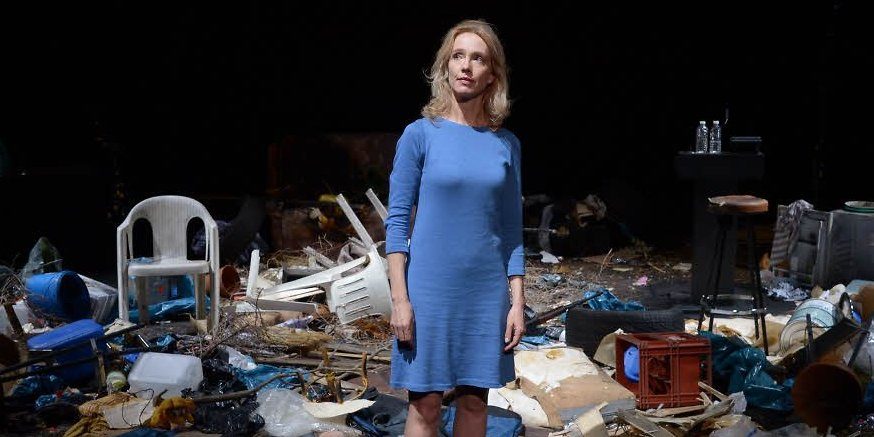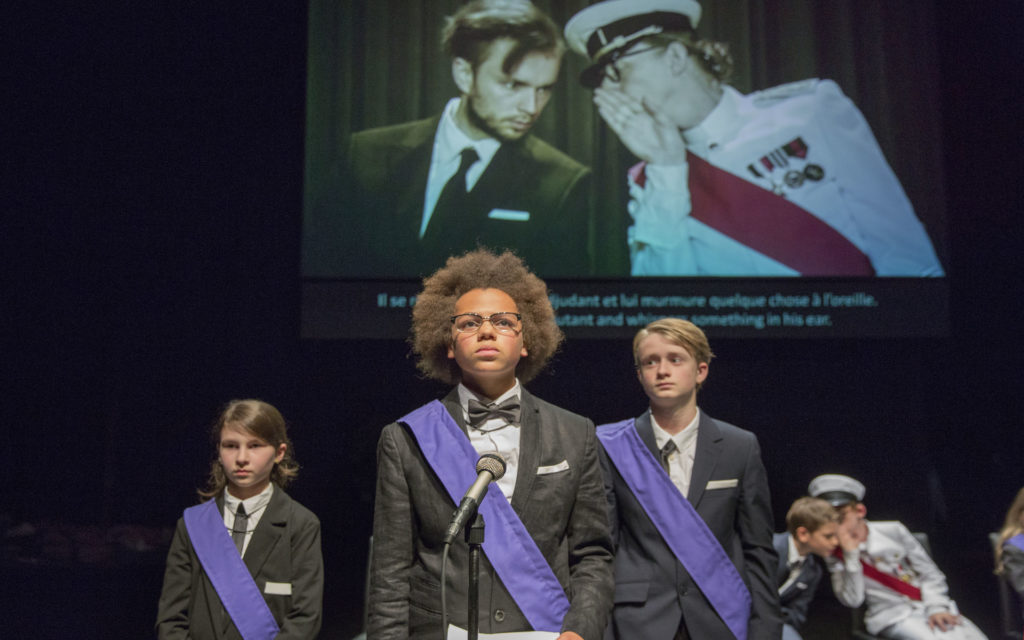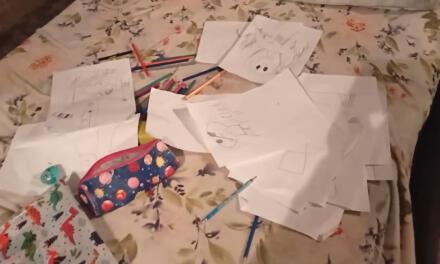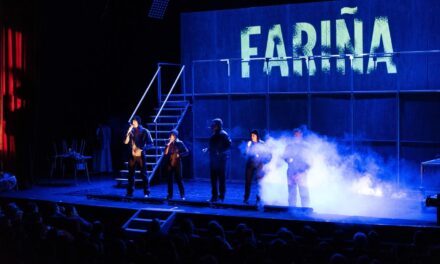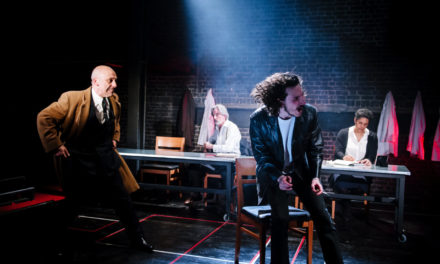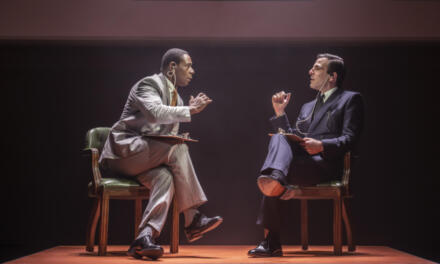Realistic rituals
Milo Rau and the International Institute of Political Murder.
The Swiss dramatist Milo Rau is causing quite a stir with his unique form of ‘research theatre.’ He does not hesitate to recreate historical events as faithfully as possible or to play around with notions of factuality, reality and representation. In what follows, we will take a closer look at three strategies Rau and his actors use to force entry into reality, along with the viewer.
It is often said that the new generation of documentary theatre-makers distinguishes itself from its predecessors by willfully blurring the border between fact and fiction on stage.[i] Indeed, the works of Rabih Mroué, Thomas Bellinck, Rimini Protokoll or Christophe Schlingensief have little in common with the essentially positivistic pursuit of documentary theatre-makers from the modern canon, such as Erwin Piscator or Peter Weiss. Influenced by Marxism, these makers used their documentary theatre to disclose a reality that was allegedly hidden behind an ideological veil which served the powerful and their worldview.
The new generation no longer adheres to the belief that theatre, by virtue of its critical outsider’s perspective, is able to magically reveal a reality that is more ‘true’ or more ‘objective’ than the reality presented by the media and the educational institutions. Quite the contrary: this new generation uses theatre to problematize the continual negotiation between reality and its inevitable representations (by the media, technology, historiography or politics). Their perspective is undeniably shaped by the deconstruction of notions like truth, actuality and knowledge.
Back in the 1930s, documentary film pioneer John Grierson already posited that a documentary is always ‘a creative treatment of reality.’ Yet in recent years, documentary theatre has increasingly turned into a heterogeneous and self-reflexive practice, in which questions of content are closely intertwined with questions of form.[ii]
The Swiss theatre-maker, filmmaker and writer Milo Rau occupies a unique position in this field. In keeping with the tradition of documentary theatre, each of his projects is the result of a long process in which artistic creation becomes intertwined with sociological, historiographical or journalistic research. That’s why Rau sometimes refers to his work as ‘Research theatre.’ His 2007 decision to call his production company International Institute of Political Murder (IIPM) betrays not only his thematic interests but also his intention to claim the borderland at the crossroads of art and academia. Scientific rigour is paired with a thorough investigation of those performative strategies that extend the formal boundaries of documentary theatre.
It is quite striking that, unlike his contemporaries, Rau has explicitly expressed a desire to connect to a regime of representation that has been reviled ever since the historical avant-garde, dismissed by the modernists and dismantled by the postmodernists, namely: realism. He has no qualms about calling his theatrical style ‘neo-realist’ or ‘new-realist.’ The ‘neo’ prefix is crucial here, suggesting as it does a kind of repetitiveness. Milo Rau’s work is inspired by the idea that it is repetitions, duplications and poetic imitations that provide access to reality.
This article will discuss three theatrical strategies from IIPM’s ‘neo-realist’ poetics. Even if they are only deployed in a few projects, these strategies take us to the heart of the philosophical and political motives that drive most of Rau’s other projects. After all, the performative strategies he uses to question the world also clarify his position on the role of theatre in that world.
Re-enactment
The first strategy is exemplified by the IIPM’s debut Die letzten Tage der Ceausescus (2009/10). For this project, Rau invited a group of Rumanian actors to reconstruct the violent Rumanian Revolution of 1989 based on extensive historical research. The performance (which was later made into a documentary film) culminated in a re-enactment of the military trial that led to the execution of the tyrannical couple Nicolae and Elena Ceausescu. As one of the first experimental theatre directors to use the strategy of re-enactment, Rau took inspiration from the well-known television broadcast of the trial. The IIPM meticulously turned the events into a theatre script, frame by frame.
Rau quickly discovered the limitations of his historical source image. The camera angle was literally ‘limited,’ showing only part of the courtroom. Rau tried to cross the line between the reality that was recorded and the reality that wasn’t by talking to a few prominent attendees of the trial, like the general who betrayed Ceausescu and one of the soldiers who participated in the execution. On stage, the courtroom was visible in its entirety. Rau ‘corrected’ the historical image by adding a piece of historical reality.
Though theatre may be fleeting, it does manage to capture a reality that used to be outside the frame of history. But does this mean that Rau believes in the possibility to reconstruct a historical reality on stage ‘as it really was’? Does he at all believe in the existence of a true representation of the past, in line with 19th-century historicism? After all, Rau has explicitly opposed the postmodern idea that history is merely a collection of stories, literary constructs that refer to each other rather than to a real-life referent.[iii]
Nevertheless, he is perfectly aware of the gap between historical facts and historical truth. That’s why authenticity or a reconstruction of the past ‘as it really was’ is never the end goal of Rau’s re-enactments. Above all, he wants to make clear that historical reality keeps happening. Therein lay the challenge: while reconstructing the Rumanian Revolution, Rau shows a factual reality that does not let itself be locked in the past, but continues to influence the present instead.
Hence Milo Rau’s unequivocal claim that the historical real reveals itself as the Lacanian real: it’s the ‘shocking and distant being-there’ that ‘horribly’ refuses to die, ‘disturbing the sleep of history.’[iv] For instance, the re-enactment in Die letzte Tage confronts the present-day audience with the unfulfilled promises of the Rumanian Revolution. These promises are what continues to interrogate the present. In Hate Radio (2011), another production in which Rau experiments with re-enactment, the IIPM reconstructed a painfully light-hearted radio show by the Rwandan radio station Radio Télévision Libre des Milles Collines, in which pop songs alternated with calls for genocide. Rau’s (partly fictionalised) reconstruction shows the trivialization of racism at its most extreme and presents the Rwandan genocide as a possible prefiguration of the future of Europe.
How do historical facts influence the present? How do they manage to produce their own reality? And how are historical facts transformed into cultural memory machines? Rau pursues this unruly factuality in almost every project. Even when he goes back to historical events that are, on the whole, pretty well-known, he tries to find out why they haven’t become settled history. They are simultaneously historical and contemporary; they belong to the past but are highly topical as well. It should not come as a surprise, then, that Rau is more interested in the cultural memory than in history as such: the real value of retrospection through re-enactment does not lie in the reconstruction of the original event, but in research into, reflection on and even the production of a cultural memory.
Wass ist Unst?, the 2009 manifesto that still has a prominent place on the IIPM’s website, states that the IIPM strives for ‘a completely literal repetition of the present through the past with an eye to the future.’ Milo Rau wants to go back-first into the future: the present understands itself through the repetition of the past. Herein lies the particular temporality of Rau’s approach: it’s not the past as such that matters; it’s its impact on the present that Rau is interested in. While historiography marks a caesura, a break between the present and the past, he wants to blur that caesura in order to lay bare the caesuras that history continues to create in the present.
The theatricalised trial
This brings us to the second duplication strategy in the realist aesthetics of Milo Rau: the theatricalised trial, of which Die Moskauer Prozesse (2012-2013) is probably the best-known example in Belgium.[v] With this project, the IIPM returns to a number of lawsuits that Russia filed against artists and curators between 2002 and 2012. Again, the present is the backdrop for this return to recent history, which is highly reminiscent of the censorship and prosecution of artists under Putin (think of the Pussy Riot trial as the most mediatised (but certainly not the only) example).
Rather than re-enacting the original trials, Rau stages a new trial in the Sakharov Centre in Moscow. The ideological opponents – not actors, but curators, artist, lawyers, religious leaders and ultranationalists, some of whom were also involved in the original trials – are invited to make their pleas (once again) within the spatio-temporal limits of the theatrical trial. At the end of this three-day quasi-juridical process, a jury of peers consisting of Muscovites must decide whether the curators and artists are guilty of committing antireligious and anti-Russian acts – thereby implicitly judging Putin’s authoritarian regime as well.
In this project, Rau does not recreate a specific historical event but rather an institutional framework: namely, the trial and its script that is embedded in Russian law (even though it is rarely applied correctly in present-day Russia). While the original trials were a charade – a spectacle with a predetermined and quite undemocratic ending – their consequences were nevertheless very real (imprisonment, forced labour). The IIPM project, by contrast, has no legal mandate, but still, there’s something at stake: the protagonists’ words are real, even though they are uttered in the context of a theatrical performance. The protagonists conduct a serious debate, and both the progressive defenders of art and the ultranationalist reactionaries are given ample time to make their case. Their credibility is at risk here. At the same time, the theatrical context emphasises the extent to which their discourse depends on rhetorical and theatrical strategies.
Milo Rau is known as a director who likes to keep a tight rein on his projects. The theatricalised trials are an exception to this. After all, though the institutional double provides him with a general outline of the legal protocol, it does not offer him a detailed scenario that defines the course of the trial. The content (the individual pleas, the interrogations) and the outcome (the jury’s verdict) are not known in advance. This orchestrated unpredictability is highlighted in Die Moskauer Prozesse when the Russian state apparatus disrupts the ongoing proceeding in the theatre: at one point, for example, the Russian immigration office interrupts the trial to check Rau’s visa.
Theatre should be a space for actual, non-play-acted debate. The IIPM allows this politico-ideological debate in all its potential unruliness. Most importantly, the audience is implicated in this dynamic of political disagreement. The strategy of the theatricalised trial leads us to another motif that recurs throughout Rau’s oeuvre: namely, the theatre as an arena where irreconcilable political, ideological and ethical positions meet, without ever reaching a consensus. It’s a space full of ‘agonistic pluralism’, to quote political scientist Chantal Mouffe. Consequently, the audience members are no longer passive spectators: they are interrogated as active witnesses of a conflict between incommensurable perspectives on reality. The theatrical framework does not relieve them of their real responsibility to actively judge what is in front of them.
Allegorical doubling
In his more recent work, like the Europe trilogy (The Civil Wars (2014), The Dark Ages (2015) and Empire, which premiered in September 2016) and Five Easy Pieces, Rau uses video images to create real-time repetitions of what happens on stage. The actors perform extensive episodes frontally for the camera while their image is simultaneously projected onto the back of the stage. Here, we will not go into what this might say about Rau’s views on acting, about liveness on stage or about mediated intimacy. What concerns us here is that this procedure transforms the actors and their personal stories into images – literally and figuratively. These images stand for something else: the intimate scenes or biographical anecdotes are turned into symptoms that allow us to diagnose and analyse the historical tensions of our time.
In Five Easy Pieces, which premiered in May 2016 during Kunstenfestivaldesarts, seven children, directed by an adult actor (Peter Seynaeve), replay scenes from the life of child killer Marc Dutroux and the investigation into his crimes. Rau’s production presents Dutroux as a key figure in Belgian post-war history: his ‘case’ has become one of the pillars of the collective mythology that defines the Belgian identity. Rather than presenting us with a series of facts that can be replayed and recounted, the Dutroux case is the via regis that leads us into the country’s collective unconscious. It takes us straight to the loss of faith in those institutions that serve to tell right from wrong and to protect both individual and societal integrity. Rau’s starting point was a statement that some of the actors made during the creation process of The Civil Wars: namely, that the last time they felt like Belgians was during the White March in 1996. At that time, 300.000 ‘Belgians’ protested against the legal and political system; 300.000 people united in loss, mistrust and powerlessness, but also in a sense of unfulfilled responsibility and implicit guilt. Paradoxically enough, Dutroux is a trauma that unites us.
Cultural memory specialist Jan Assmann stresses the importance of what he calls ‘memory-figures’: ‘culturally shaped, socially bonding memory pictures’ that usually refer to significant events in the history of a nation. These events are commemorated in celebrations, ceremonies and historical images – in short, in all kinds of recurring (re-)stagings. Rau contrasts this effective, ‘healthy’ cultural memory to the negative memory-figure of Dutroux. By having child actors replay episodes from his life, Rau creates a ritual repetition that sustains the cultural memory of these events.
It is a signature strategy of Rau to turn a personal story into an allegory of a historical problem field that both surpasses and influences the personal. Five Easy Pieces connects the Dutroux case to analogous but different moments when innocence is lost (or, to be more precise, when the clear distinction between guilt and innocence disappears). Throughout the performance, Rau looks for a similar ‘fall from innocence’ by having 8- to 13-year-old kids replay the horror story, by interrogating them on stage and (almost literally) expose them to the gaze of the audience.
In an interview with dramaturg Stefan Blaske, Rau has declared explicitly that the message he wants to convey is that children’s theatre is a one-sided and voyeuristic power trip that children must endure. In other words, this ‘child’s play’ also reflects on the history of theatre as a medium, and on the moral boundaries of what can and cannot be shown on stage, and by whom. Or as Rau puts it, Five Easy Pieces becomes ‘a meta-study on performance art and its tradition of change, subjection, and rebellion’.
Yet there is another redoubling at work in Five Easy Pieces as well – one that is just as important to discuss within this context. Right from the start, the memory-figure of Dutroux is linked to a less visible, but no less dramatic cultural ‘trauma’: the aftermath of Congo’s independence and the murder of Patrice Lumumba, which was commissioned, among others, by the Belgian government.
Using a personal biography as a steppingstone to a larger political or historical framework is a popular strategy in documentary literature, cinema and theatre. Yet Rau appropriates it in a particular way: by introducing ambiguous figures. In Five Easy Pieces, the children reveal bits of their personal history, while simultaneously evoking Dutroux and the postcolonial heritage as abyssal memory-figures of a Belgian identity. While in The Civil Wars, the actors’ personal testimonies about their complex relationship with their fathers become a symbol for the current state of Europe, which also lacks a father figure and is therefore just as orphaned and aimless, according to Rau. Time and again, his performances return to the societal and intellectual disorientation of Western Europe in a post-historical time. As paradoxical as it may seem, it’s precisely this trauma that unites us as a community.
In conclusion
The realistic reproduction of reality has increasingly come under pressure these last few decades. Documentary realism is said to be inadequate at capturing a complex and chaotic reality in which heterogeneous dynamics are at play. The realistic strategies that we’ve discussed here – re-enactment, the theatricalised trial, and allegorical doubling – allow Rau to clearly and unequivocally demonstrate the unsettling ambiguity of human beings and their society. Realism does not reduce this complexity. On stage, reality is both then and now, both theatrical and real, both specific and allegorical.
Frederik Le Roy is a PhD research and teaching assistant at the department of Art, Music and Theatre Studies at Ghent University and the content coordinator of the Master in Drama at KASK / School of Arts.
This article was originally posted at http://www.e-tcetera.be Reposted with permission. To read the original article, click here.
[i] See for instance: Irmer, Thomas. ‘A Search for New Realities. Documentary Theatre in Germany’. In TDR 50.3, MIT Press, Cambridge, MA, 2006, p. 16-28. And: Martin, Carol, Theatre of the Real, Palgrave Macmillan, Basingstoke, 2013.
[ii] To such an extent that Carol Martin coined the term ‘theatre of the real’.
[iii] For Rau’s critique of postmodern thought, see his essay collection Althussers Hände. Essays und Kommentare (Verbrecher Verlag, Berlin, 2015) and multiple interviews in Rolf Bossart (ed.), Die Enthülling des Realen. Milo Rau und das Internal Institute of Political Murder, Theater der Zeit, Berlin, 2013.
[iv] Ibid, p. 240.
[v] Other examples are Die Zürcher Processe (2013) and Das Kongo Tribunal (2015-2016; the documentary movie is scheduled to premiere in 2017).
This post was written by the author in their personal capacity.The opinions expressed in this article are the author’s own and do not reflect the view of The Theatre Times, their staff or collaborators.
This post was written by Frederik Le Roy.
The views expressed here belong to the author and do not necessarily reflect our views and opinions.

